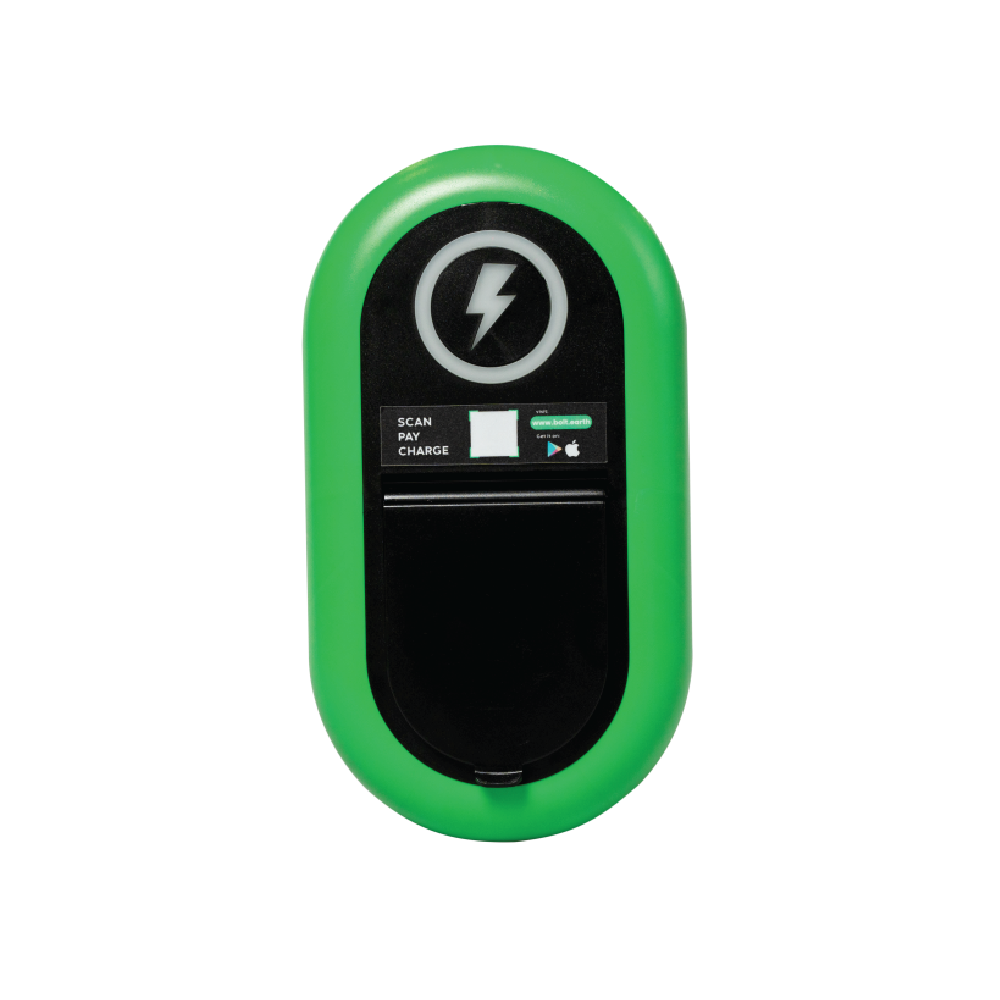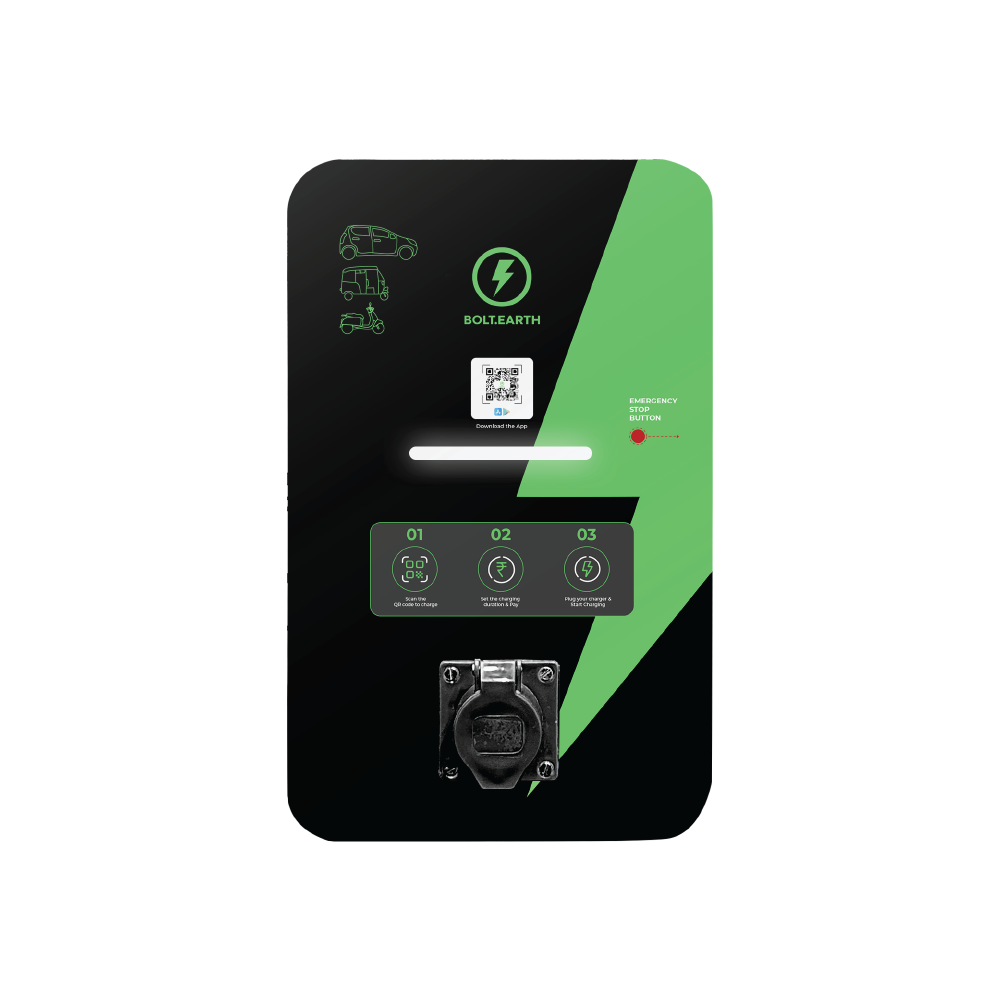5-Point Guide to Earning Revenue With EV Charging
Raghav Bharadwaj
Chief Executive Officer
Published on:
26 Aug, 2025
Updated on:
04 Dec, 2025

India is in the midst of an electric vehicle revolution, and with it comes a gold rush for accessible, reliable EV charging infrastructure.
Over 5.91 million EVs are already on Indian roads as of April 2025, with electric two-wheelers accounting for approx. 59% of sales. Yet charging stations remain relatively scarce roughly 26,000 public chargers serving those millions of EVs, about 1 charger per 235 EVs. By comparison, China has about 1 per 7 vehicles.

A Confederation of Indian Industry report estimates India will need around 1.32 million charging stations by 2030 to support the expected EV growth. Analysts project India’s EV market could generate over $100 billion in revenue by 2030, and robust charging infrastructure is key to unlocking this opportunity.
For entrepreneurs and businesses, this gap between EV adoption and charging infrastructure is an invitation. But how to make money with EV charging isn’t as simple as installing a charger and waiting for EV owners to show up. Much like petrol station owners learned to diversify beyond selling fuel, EV charging entrepreneurs must employ smart strategies to maximize revenue.
In this 5-point guide, we’ll explore how you can earn revenue with EV charging in India, from choosing the right location and pricing model to offering value-added services and leveraging government incentives.
1. Strategic Location and High Utilization Are Key
Just as in real estate, location is the mantra for EV charging stations. A charger’s earning potential is tied to how often it’s used, i.e., its utilization rate. Many charging stations in India today suffer from low utilization, often only approx. 5%, meaning they’re used just a few hours a day.
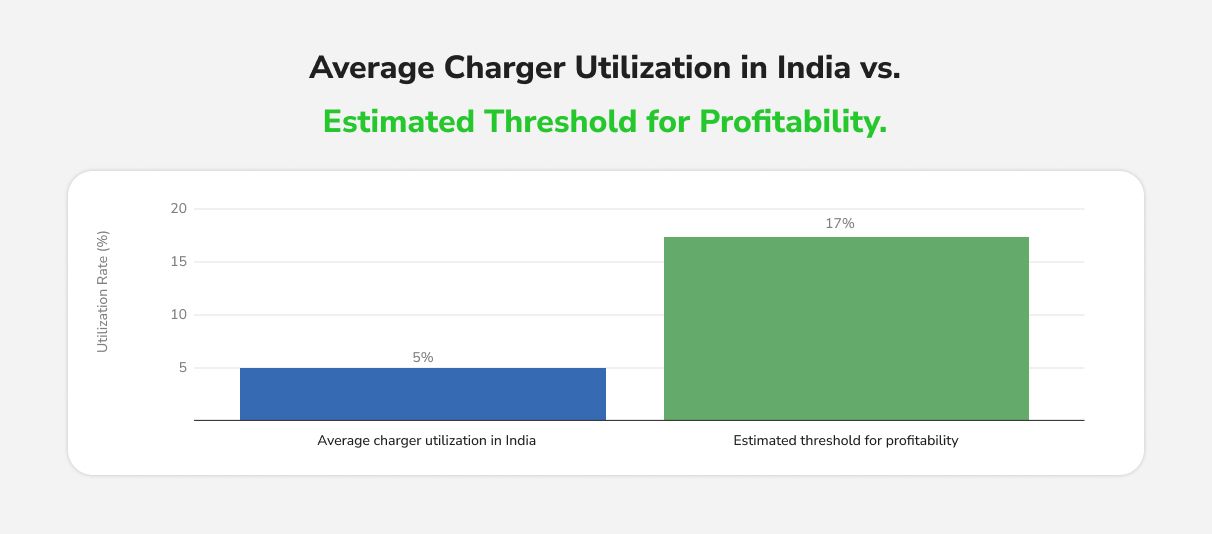
At 5% utilization, a charger sits idle 95% of the time, a recipe for delayed returns. The lesson? Place your chargers where the demand is. High footfall areas bring steady traffic, increasing your revenue potential. A station on a busy highway or in a popular mall is akin to a shop in a crowded bazaar.
Think about where EV owners spend time. Ideal spots include shopping centers, office complexes, parking lots in dense residential areas, highway rest stops, and petrol pumps adding EV charging. Situating chargers at supermarkets or cinemas means drivers can top up while they shop or catch a movie, turning waiting time into useful time.
Location also impacts costs and partnerships. If procuring real estate is a challenge, consider creative partnerships. In dense urban neighborhoods, collaborate with local shops or housing complexes. A great example is tying up with small neighborhood stores (kirana shops) for installing charging points. Under a revenue-sharing model, the shop provides space and oversight, while you provide the charger; both parties then share the revenue. This can be a win-win: you secure a prime location with built-in community trust, and the shop benefits from additional foot traffic. The Indian government’s think tanks have even recommended such models, e.g., DISCOMs (electric utilities) partnering with kirana stores in crowded areas to host two-wheeler/three-wheeler chargers.
Moreover, scale matters. A lone charger might struggle, but a cluster or a network effect can draw more EV users. Many major players are rapidly expanding networks in strategic locations. The goal is to place chargers where EVs are concentrated: urban centers like Bengaluru, Delhi, and Mumbai and along key travel corridors. States like Karnataka and Maharashtra lead in charging point count, reflecting higher EV adoption.
Finally, uptime and reliability are part of “utilization.” Choose locations with a stable electricity supply (or invest in a good backup). Nothing chases away repeat customers like a charger that’s often “Out of Order”. Treat your charging station like a retail business: a great location, easy accessibility, and reliability will drive higher usage, directly boosting revenue.
2. Optimize Pricing and Charging Fees
The most straightforward revenue stream for an EV charging operator is the charging fee, selling electricity as a service. But setting the right pricing strategy can make or break your business. Price too high, and drivers will detour to a competitor; price too low, and you might not cover costs. The key is to optimize pricing and find the sweet spot that attracts customers while ensuring a healthy margin.
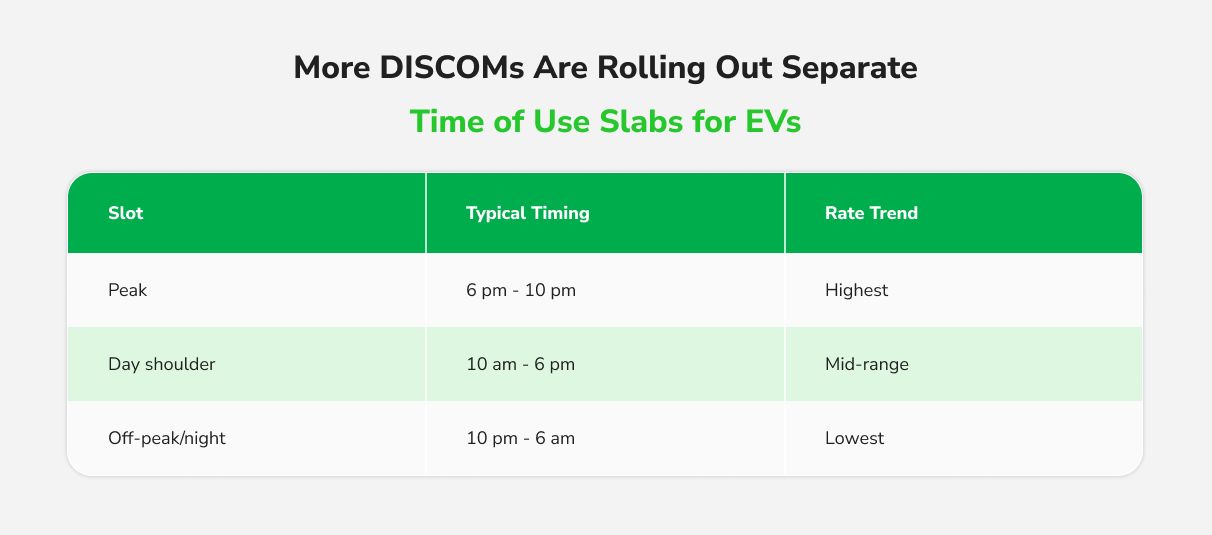
In India, public EV charging rates typically range around ₹10–14 per kWh for AC chargers (slow/medium speed) and ₹18–22 per kWh for DC fast chargers. These prices are significantly higher than residential electricity rates (often 2–3× the home charging cost), effectively a “convenience premium”. Many are willing to pay more for the convenience of a fast charge. After all, using a 60 kW fast charger might refill a battery in 40 minutes versus 8 hours at home.
One smart approach is dynamic pricing, or time-of-use pricing. You can vary charging tariffs based on demand and time of day. Charging during off-peak night hours (e.g., 10pm–6am) might cost 30–50% less than peak hours. Encourage EV charging for fleets or drivers to charge overnight or midday by offering discounted rates, and apply slightly higher rates during the evening peak. This boosts utilization in off-peak times but reduces grid strain.
Transparency and fairness in pricing are crucial. EV drivers are highly cost-conscious (a difference of ₹1 per kWh adds up over a full battery). Ensure your fee structure is clear, whether you charge per kWh, per minute, or a combination. In India, most public chargers charge per kWh consumed, which is generally seen as fair. You might also consider session fees (a flat start fee) or tiered pricing (the first 15 minutes at one rate and then a different rate) to encourage efficient use.
Policy trends are nudging prices downward: the central government has recommended guideline tariffs as low as ₹4/kWh for slow charging and ₹7/kWh for fast charging (far below what many operators charge today). While not enforced uniformly, this signals a push to keep EV charging affordable. Also, electricity is often the biggest operational cost. Tapping into special EV tariff plans or sourcing renewable energy can lower your input cost, allowing you to maintain margin even at competitive prices.
To illustrate why smart pricing matters, consider an analysis by McKinsey in the US, which showed that public fast-charging stations face challenging economics because utilization is still ramping up. They found that at around 15% utilization (about 7 fast-charge sessions a day), a typical station barely breaks even on operating costs at current prices. The only way to improve this is to increase utilization and optimize pricing, exactly what we’ve discussed.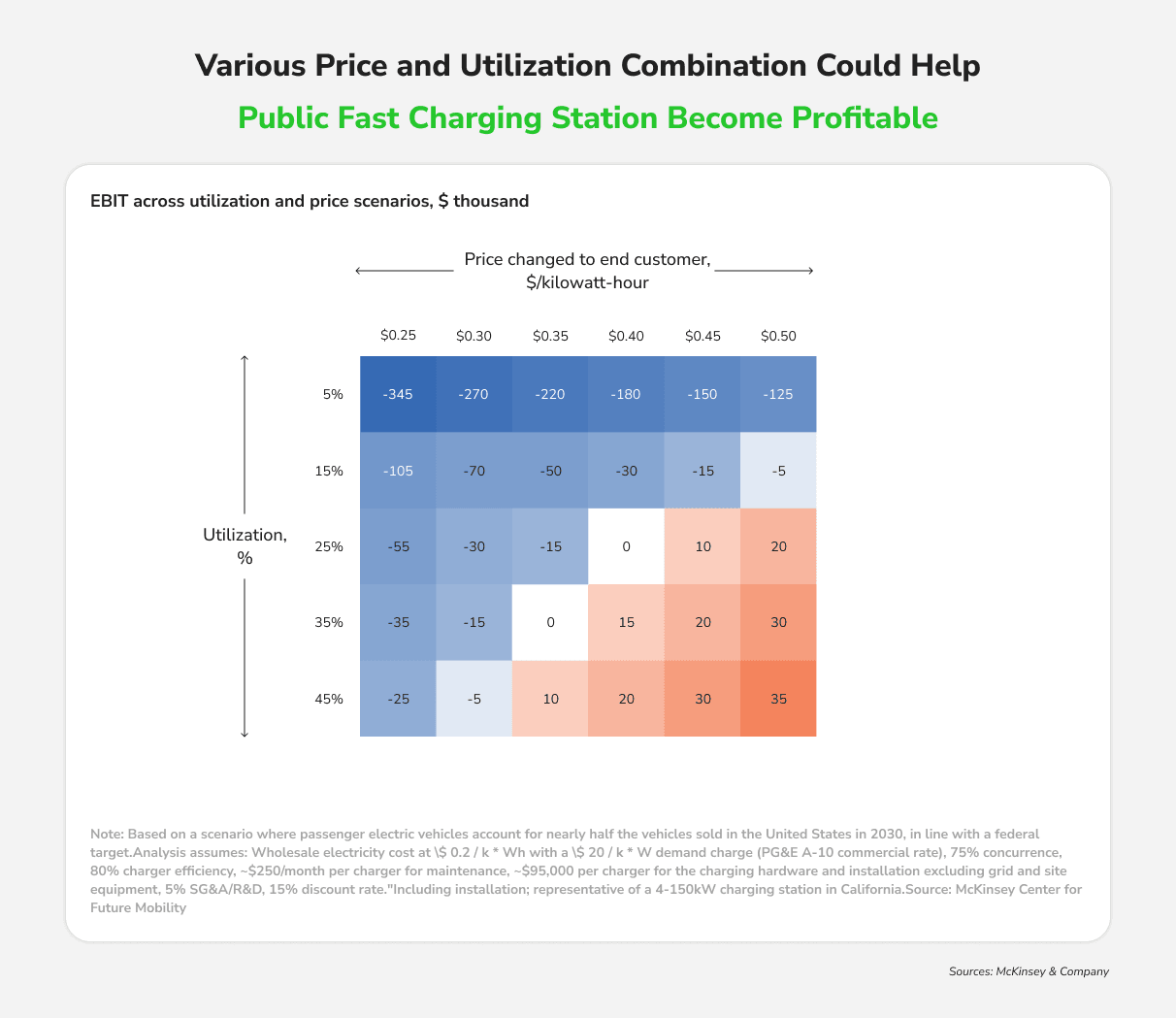
In India’s context, where utilization might be even lower initially, you simply must get more EVs in and charge what the market can bear.
Bottom line: treat pricing as a strategic tool. Monitor what others charge, stay updated on tariffs, and be ready to adjust. When pricing is done right, you’ll maximize revenue per unit and keep the chargers busy.
3. Offer Subscriptions and Loyalty Plans for Steady Income
Would you rather have a customer who uses your charger once in a blue moon or one who uses it regularly? The latter is obviously better for stable revenue. That’s where subscriptions and membership programs come in, a growing trend that can lock in customer loyalty and provide predictable income.
Many EV charging networks worldwide and in India are introducing subscription plans. For a monthly fee, a member could get discounted rates, some “free” charging credit, priority access to chargers, or the ability to reserve a slot during busy hours. For high-mileage users like fleet drivers or daily commuters, this offers convenience and savings. For the operator, it means predictable revenue and a higher likelihood of repeat usage. As one industry source puts it, offering subscription packages provides predictable revenue streams; customers enjoy cost savings and convenience, while operators enjoy steady income.
For an EV charging station business, loyalty pays off in multiple ways. Subscriptions can also be tiered (e.g., Silver, Gold, and Platinum plans) for different segments: perhaps a two-wheeler rider might opt for a lower-cost plan, whereas a taxi fleet might pay for a premium plan.
Don’t forget B2B and fleet partnerships. Strike deals with corporate fleets, cab aggregators, e-commerce delivery companies, or housing societies. If you sign an agreement with an electric taxi company, they might pay you a fixed monthly fee or guarantee a minimum number of charging sessions. This is huge in India, where commercial EV fleets (electric rickshaws, ride-share cabs, delivery vans, etc.) are growing fast. McKinsey has noted that globally, services to support EV charging for fleets are an emerging revenue pool, estimated to be $15 billion annually by 2030 in the US. The same trend will come to India. Fleet operators would rather outsource charging infrastructure. By providing tailored plans, you secure a consistent customer base that keeps your chargers busy day in and day out.
4. Diversify Revenue Streams: Beyond Just Electricity
Charging fees is the core of your business but shouldn’t be the only revenue source. Smart entrepreneurs are turning their stations into multi-faceted hubs. Think of how petrol pumps evolved over the years. They added convenience stores, coffee shops, ATMs, car washes, and even QSR franchises – because selling snacks or offering services can be far more profitable than fuel alone. An EV charging station can be more than a plug; it can be an experience.

Here are some lucrative side hustles for your EV charging station business opportunities:
- On-site Retail and Food: A fast charger means 20-40 minutes of dwell time. If you have space, set up a small café or tie up with a food truck. Even a vending machine or a tie-in can entice customers. Remember, at gas stations “snacks, drinks, and everyday essentials have much higher profit margins than fuel”. Make your charging stop a pleasant place to take a break. Some highway charging plazas in India are already doing this, essentially becoming the new-age “charging dhaba” where both car and driver recharge.
- Advertising and Sponsorship: If your station is in a high-visibility location, monetize that visibility. Digital screens or a big billboard can host ads. Brands that associate with green mobility want visibility; you could host ads for them. This can create an additional revenue stream at very low incremental cost.
- Value-Added Vehicle Services: Consider offering services like car wash/detailing, tire check, or minor maintenance at your station. An EV may not need oil changes, but basics like tire pressure top-up or windshield cleaning could be offered. If a driver can get their car cleaned while charging, that’s added value (and you can charge for it). These services can be outsourced; perhaps a car detailing company pays you rent or commission to operate at your site on weekends. It’s another way to utilize the time the vehicle is parked and make the station a one-stop shop.
- Retailing EV Accessories or Products: With EVs, there’s a whole new ecosystem of products – portable chargers, charging cables, adapters, EV-themed merchandise, and even snacks for the road. A small retail kiosk or an automated locker could sell these to drivers. For example, an EV driver might realize they need a better charging cable lock or an extra adapter for a specific socket; if you sell those on-site, that’s instant extra revenue.
- Partnering with Host Businesses: Earlier we discussed partnering for location (like kirana shops). Such partnerships can also involve revenue sharing on other services. For example, if your charger is at a supermarket parking lot, arrange discounts for users and share revenue. Co-location with retail can drive foot traffic to both the charging station and the store.
Providing free Wi-Fi or seating might not directly earn revenue but can increase dwell time and customer satisfaction. Some stations internationally are even considering co-working spaces or playgrounds. While those might be big investments, the core idea is to maximize the earning potential of every minute that a vehicle is at your station.
One more angle: data and technology. Your chargers generate data on usage data. Aggregated and anonymized, this could be valuable for research or utilities. Down the line, there may be opportunities to monetize insights. Even now, some charging providers might partner with map services or EV manufacturers to share station usage stats in exchange for something (not necessarily direct revenue, but increased visibility).
5. Leverage Government Incentives and Plan for Future Opportunities
The Indian government is an active enabler, offering incentives, subsidies, and policy support. Take full advantage of these schemes and position yourself for future trends like renewable energy integration.
Tap into Subsidies and Grants
The FAME-II scheme (Faster Adoption and Manufacturing of Electric Vehicles) allocated subsidies for public charging stations. It earmarked ₹1,000 crore toward installing about 7,000 chargers by 2024. In 2024 the government launched PM E-DRIVE with a ₹10,900 crore (~$1.3 billion) outlay, including ₹2,000 crore for public chargers (22,000+ stations by 2026). These funds are being disbursed as capital subsidies or in public-private partnership models to encourage private players like you to set up stations.
Translation: there’s potentially money on the table to cover a portion of your charger purchase or installation costs. Keep an eye on EV policies from the Ministry of Heavy Industries and state nodal agencies; they often invite proposals for subsidized projects. If you can get, say, 30-50% of your equipment cost reimbursed by a scheme, your path to profitability becomes much quicker.
In addition to central schemes, state governments have their own incentives. Many states, like Maharashtra, Gujarat, Delhi, Telangana, and Tamil Nadu, to name a few, offer perks such as capital subsidies, electricity tariff concessions, discounted land rent, or tax exemptions for charging infrastructure.
Tax Benefits and Credits
The government also provides indirect boosts. Tax benefits include lower GST, only 5% GST vs. 18% on petrol/diesel, depreciation benefits, and carbon credit programs. India is developing a carbon credit market; if you power your station with renewable energy or help offset emissions, you might earn tradable carbon credits or Renewable Energy Certificates (RECs). Major corporations in India are also interested in sponsoring green infrastructure as part of CSR or carbon-offset initiatives, meaning you could find corporate funding or partnerships if you position your charging station as 100% solar-powered, for example.
Speaking of solar, energy management is the future. As your operation grows, consider integrating renewable energy or battery storage at your charging site. For instance, installing a solar PV canopy above the charging bays not only provides shade but also generates power that can cut your electricity bills. Over a year, solar can significantly offset grid consumption, improving your profit margins (after the payback period of panels). Additionally, if your station has battery storage, you can store cheap off-peak power (or solar power) and use it during peak hours, shaving those nasty demand charges and reducing your draw from the grid when electricity is expensive.
Another government-driven opportunity: participating in grid services or load management programs. Utilities may offer incentives if you help them manage load, e.g., by curtailing charging during peak demand or providing battery backup to support the grid. In the US, some operators earn via energy credits for using renewable power or by enrolling in demand response programs. In India, similar mechanisms will evolve as EV load grows. Keep an ear out for pilot programs by bodies like SECI or state DISCOMs that seek to integrate charging stations into smart grid projects.
Final Thoughts
Earning revenue from EV charging in India is a multifaceted game, one that blends infrastructure, customer-centric services, and policy alignment.
To recap our journey:
- Choose your locations wisely and drive utilization through the roof; an idle charger is a money pit, while a busy charger is a cash register that keeps ringing.
- Get your pricing right. Not just right in terms of covering costs, but strategically right to attract and retain customers. Don’t shy away from innovative pricing models that reward off-peak use or loyal users.
- Cultivate loyalty and lock in recurring revenue with subscriptions or fleet contracts; this provides stability in a growing yet volatile market.
- Don’t just sell electricity, sell convenience, sell comfort, sell services, and sell eyeballs (to advertisers)! Diversifying your revenue streams can often be the difference between a barely-breaking-even station and a thriving, profitable enterprise.
- Lastly, ride the tailwinds provided by government and technology. Take every incentive you can and be ready for the next wave (be it a new subsidy, a new battery tech, or a new way to monetize energy).
In conclusion, by following this five-point guide and keeping a keen eye on market trends, you can do more than just keep the lights on; you can charge up substantial profits while playing a pivotal role in India’s clean mobility revolution. Your EV charging business can fuel (or shall we say, electrify) not only vehicles but also your entrepreneurial success.
After all, the vehicles of the future are electric, and they all need a charge. Both you and the nation stand to gain by making that charge as accessible, efficient, and rewarding as possible.




